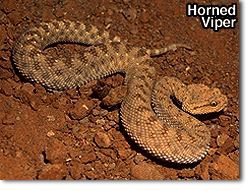Horned viper (Cerastes cerastes gasperetii )
 Similar in appearance to the false horned viper, is the horned viper (Cerastes cerastes gasperetii ) often also referred to as the sand viper. Confusion arises in the identification of this animal, because some have horns, whereas others completely lack any trace of horns. It reaches a length of about 85 cms, with the typical stocky viper body and a very broad head. They have long hinged teeth and also move in a side-winding manner in soft sand, which is their favoured habitat. Adapted to the open desert it is creamy-beige in colour, with darker blotches on its back. In the Emirates it is found in all the sandy deserts from the coast up to the mountain plains where there is virtually no shade available. The horned viper is almost entirely nocturnal, spending the day under anything that provides a little shelter from the sun. If no shade is available it buries itself in the sand by moving its ribs forward, and at the same time upward, causing the sand to be pushed to the side and allowing the otherwise motionless animal to sink below the surface in a manner reminiscent of a submerging submarine. Within a very short time nothing is visible but the eyes, which are set very high on top of the vipers head. Similar in appearance to the false horned viper, is the horned viper (Cerastes cerastes gasperetii ) often also referred to as the sand viper. Confusion arises in the identification of this animal, because some have horns, whereas others completely lack any trace of horns. It reaches a length of about 85 cms, with the typical stocky viper body and a very broad head. They have long hinged teeth and also move in a side-winding manner in soft sand, which is their favoured habitat. Adapted to the open desert it is creamy-beige in colour, with darker blotches on its back. In the Emirates it is found in all the sandy deserts from the coast up to the mountain plains where there is virtually no shade available. The horned viper is almost entirely nocturnal, spending the day under anything that provides a little shelter from the sun. If no shade is available it buries itself in the sand by moving its ribs forward, and at the same time upward, causing the sand to be pushed to the side and allowing the otherwise motionless animal to sink below the surface in a manner reminiscent of a submerging submarine. Within a very short time nothing is visible but the eyes, which are set very high on top of the vipers head.
|